7-9 Saturn’s atmosphere, surface, and interior are similar to Jupiter
Focus Question 7-8
What two effects cause Saturn’s belt and zone system?
Partly obscured by the thick, hazy atmosphere above them, Saturn’s clouds lack the colorful contrast visible on Jupiter. Nevertheless, photographs do show faint stripes in Saturn’s atmosphere (Figure 7-20), similar to Jupiter’s belts and zones. Their existence indicates that Saturn also has internal heat that transports the cloud gases by convection. Changing features in the atmosphere show that Saturn, too, has differential rotation—ranging from about 10 hours and 14 minutes at the equator to 10 hours and 40 minutes at high latitudes. As on Jupiter, some of the belts and zones move eastward, while others move westward. In 2006, the Cassini spacecraft revealed a hexagonal boundary surrounding Saturn’s north pole (Figure 7-21a). While belts, zones, and large-scale storms (Figure 7-21b) flow around it, this feature is nearly stationary. The mechanism that creates and maintains the boundary is still under investigation.
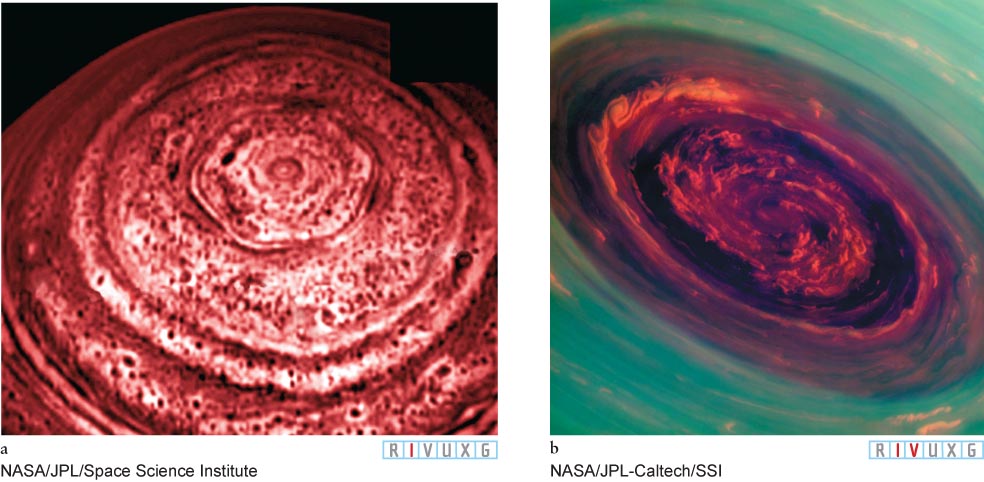
Figure 7-21: 
 Belts and Zones on Saturn (a) Observing in the infrared, Cassini took this view of a hexagonal pattern of clouds that rotates much more slowly than the surrounding belts and zones. The pattern’s origin is still under investigation. (b) Observed in visible light, the north pole is covered by and encircled by huge storms, imaged by Cassini in 2012.
Belts and Zones on Saturn (a) Observing in the infrared, Cassini took this view of a hexagonal pattern of clouds that rotates much more slowly than the surrounding belts and zones. The pattern’s origin is still under investigation. (b) Observed in visible light, the north pole is covered by and encircled by huge storms, imaged by Cassini in 2012.
Although Saturn lacks a long-lived spot like Jupiter’s Great Red Spot, it does have hurricane-like storms. Every 30 years or so (which is one Saturnian year), the planet experiences a powerful white storm. Lesser storms occur more randomly. In 2004, a pair of storms was observed to merge (Figure 7-22). One of the most powerful storms seen on Saturn in decades occurred throughout most of 2011. It eventually encircled a wide swath of Saturn’s northern hemisphere, with its head eventually overtaking its tail (Figure 7-22e–j). Before dissipating late in 2011, it caused the temperature in Saturn’s atmosphere over it to soar 80 K (120oF) above normal and also led to the emission of a vast quantity of ethylene, a colorless, odorless gas. The source of that gas in Saturn is at present unknown. In 2004, Cassini detected lightning in Saturn’s atmosphere.
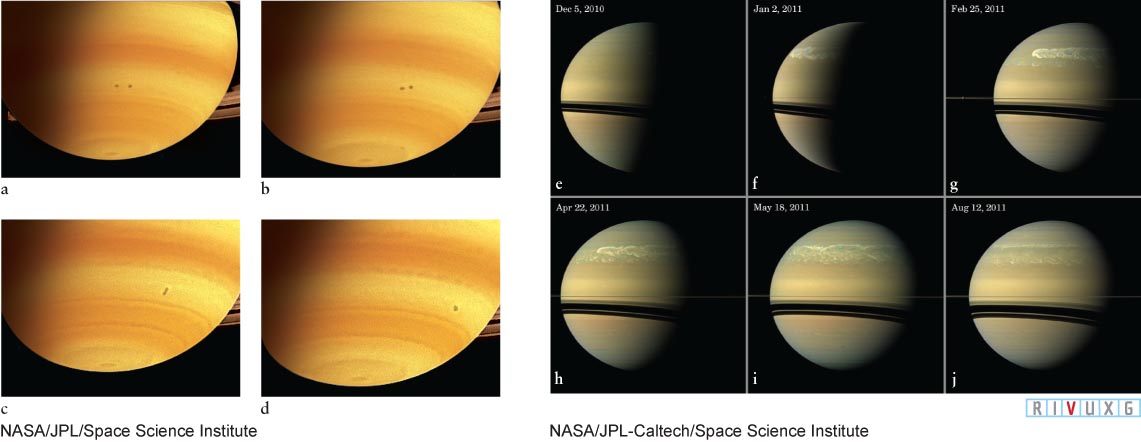
Figure 7-22:  Merging Storms on Saturn (a–d) This sequence of Cassini images shows two hurricane-like storms merging into one on Saturn in 2004. Each storm is about 1000 km (600 mi) across. (e–j) This storm swept around Saturn’s northern mid-latitudes throughout 2011.
Merging Storms on Saturn (a–d) This sequence of Cassini images shows two hurricane-like storms merging into one on Saturn in 2004. Each storm is about 1000 km (600 mi) across. (e–j) This storm swept around Saturn’s northern mid-latitudes throughout 2011.
Saturn’s atmosphere is composed of the same gases as Jupiter’s atmosphere. However, because its mass is smaller than Jupiter’s, Saturn’s gravitational force on its atmosphere is less. Therefore, Saturn’s atmosphere is more spread out than that of its larger neighbor (see Figure 7-6). Saturn has impressive surface winds. At its equator, storms have been clocked moving at speeds of 1600 km/h (1000 mi/h), which is 10 times faster than Earth’s jet streams and 3 times faster than the fastest winds on Jupiter. The reason for Saturn’s extremely high wind speeds is still under investigation.
As noted previously, the chemical composition of Saturn’s atmosphere is different from that of Jupiter: Saturn’s atmosphere is about 96.3% hydrogen and 3.3% helium, whereas Jupiter’s atmosphere is about 89.8% hydrogen and 10.2% helium. A related observation is that Saturn emits about 2.3 times as much energy as it receives from the Sun. Unlike Jupiter, whose extra energy is emitted primarily by the Kelvin-Helmholtz mechanism, much of Saturn’s extra energy is believed to be generated by a mechanism called helium rain. Helium rain works like this: Because it is smaller than Jupiter and farther from the Sun, Saturn’s atmosphere is cool enough for the helium in it to condense into liquid droplets that then descend deep into the planet. As the helium rain strikes the interior, the rain’s energy helps heat the planet; the planet then in turn radiates that energy.
Astronomers infer that Saturn’s interior structure resembles that of Jupiter. A layer of molecular hydrogen just below the clouds surrounds a layer of liquid metallic hydrogen and a rock and metal core (see Figure 7-8).
Because of its smaller mass, Saturn’s interior is also less compressed than Jupiter’s, so the pressure inside Saturn is insufficient to convert as much hydrogen into liquid metal. Its lower temperature and pressure, compared to Jupiter, prevent Saturn’s core from dissolving. The radius of Saturn’s rocky core is about 7400 km (4600 mi) while its layer of liquid metallic hydrogen is 12,000 km (7460 mi) thick (see Figure 7-8). To alchemists, Saturn was once associated with the extremely dense element lead. This is wonderfully ironic in that at 687 kg/m3 (1160 lb/yd3), Saturn is, on average, the least dense body in the entire solar system; an object with that density on Earth would float on water.
7-10 Saturn’s spectacular rings are composed of fragments of ice and ice-coated rock
Saturn’s magnificent rings are among the most interesting objects in the solar system. They are tilted 27° from the perpendicular to Saturn’s plane of orbit, so sometimes they are nearly edge-on to us, making them virtually impossible to see from Earth (Figure 7-23). In 1675, Giovanni Cassini discovered an intriguing feature—a dark division in the rings. Called the Cassini division, this gap of 5000 km (3100 mi) separates the dimmer A ring from the brighter B ring, which lies closer to the planet. By the mid-1800s, astronomers using improved telescopes detected a faint C ring just inside the B ring. Figure 7-24 shows a modern perspective of these rings.
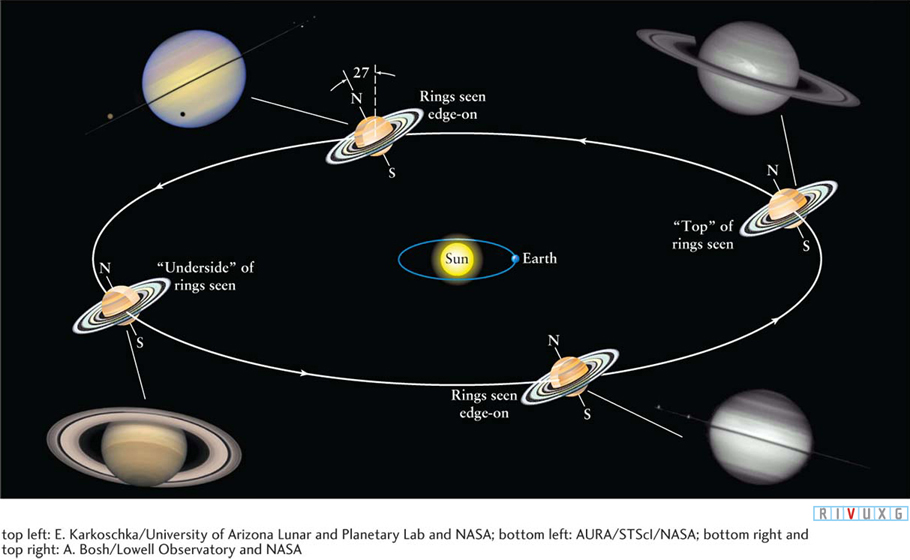
Figure 7-23:  Saturn as Seen from Earth Saturn’s rings are aligned with its equator, which is tilted 27° from the plane of Saturn’s orbit around the Sun. Therefore, Earth-based observers see the rings at various angles as Saturn orbits the Sun. The plane of Saturn’s rings and equator keeps the same orientation in space as the planet goes around its orbit, just as Earth keeps its 23½° tilt as it orbits the Sun. The accompanying Earth-based photographs show how the rings seem to disappear entirely about every 15 years
Saturn as Seen from Earth Saturn’s rings are aligned with its equator, which is tilted 27° from the plane of Saturn’s orbit around the Sun. Therefore, Earth-based observers see the rings at various angles as Saturn orbits the Sun. The plane of Saturn’s rings and equator keeps the same orientation in space as the planet goes around its orbit, just as Earth keeps its 23½° tilt as it orbits the Sun. The accompanying Earth-based photographs show how the rings seem to disappear entirely about every 15 years

Figure 7-24:  Numerous Thin Ringlets Constitute Saturn’s Inner Rings (a) This Cassini image shows some of the structure of Saturn’s rings, including some of the moonlets orbiting in them. Lower inset: As moons orbit near or between rings, they often cause the ring ices to develop ripples, like the grooves in a phonograph record. Three insets on right: Circles indicate four moonlets in the A ring. (b) Debris piles up along the outer edge of Saturn’s B ring just inside the Cassini division. Note the shadows of this material, indicating how irregular this edge is compared to the body of the ring. (c) Viewing Saturn’s night side, the smaller pieces of debris scatter light from the Sun forward toward the Cassini spacecraft, including dust-sized particles in the Cassini division. Note that the Cassini division is bright in this image, while the B ring is quite dark.
Numerous Thin Ringlets Constitute Saturn’s Inner Rings (a) This Cassini image shows some of the structure of Saturn’s rings, including some of the moonlets orbiting in them. Lower inset: As moons orbit near or between rings, they often cause the ring ices to develop ripples, like the grooves in a phonograph record. Three insets on right: Circles indicate four moonlets in the A ring. (b) Debris piles up along the outer edge of Saturn’s B ring just inside the Cassini division. Note the shadows of this material, indicating how irregular this edge is compared to the body of the ring. (c) Viewing Saturn’s night side, the smaller pieces of debris scatter light from the Sun forward toward the Cassini spacecraft, including dust-sized particles in the Cassini division. Note that the Cassini division is bright in this image, while the B ring is quite dark.
The Cassini division occurs because the gravitational force from Saturn’s moon Mimas combines with the gravitational force from the planet to keep the region relatively clear of debris. Whenever matter drifts into the Cassini division, Mimas (orbiting at a different rate than the matter in the Cassini division) periodically exerts a force on this matter, eventually pulling most of it out of the division. This effect is called a resonance and is similar to what happens when you repeatedly push someone on a swing at the right time, giving them energy that enables them to go higher and higher.
Despite the resonance keeping the Cassini division relatively clear of larger (boulder-sized) debris, it is filled with dust-sized particles. We know this because, like particles near a window in a room with sunlight streaming in, such dust-sized particles in the Cassini division scatter light forward rather than backward as larger pieces of matter do. We see everything around us because these things scatter light back off their surfaces toward us. Dust primarily scatters forward. When Cassini passed Saturn and looked back at its dark side, the dust particles in the Cassini division and the Encke division, discussed below, scattered light forward, toward the spacecraft, so that the divisions were not dark as seen from that perspective (Figure 7-24c). Further evidence for the existence of tiny debris particles in Saturn’s rings where we see nothing from Earth came when spacecraft Cassini passed through a gap in the ring plane just outside the F ring (see Figure 7-24c). During that passage, it was peppered with 100,000 impacts from these dust particles in less than 5 minutes.
The outer edge of the B ring, just inside the Cassini division, has shown interesting structure in an image taken by the Cassini spacecraft. While most of the ring is only 10 m (30 ft) thick, debris piling up along that edge pushes above and below the plane of the disk (Figure 7-24b), creating a hem running around the ring, like the hem around the bottom of a skirt. This thickened part of the ring has peaks of debris ranging up to 2.5 km (1.6 mi) above the plane of the B ring. It is apparently caused by ring material flowing toward the edge of the ring and then, unable to enter the Cassini division, it flows perpendicular to the ring.
Focus Question 7-9
Why are there gaps in Saturn’s rings?
A second gap exists in the outer portion of the A ring, named the Encke division (Figure 7-24 and Figure 7-25), after the German astronomer Johann Franz Encke, who allegedly saw it in 1838. (Many astronomers have argued that Encke’s report was erroneous because his telescope was inadequate to resolve such a narrow gap.) The first undisputed observation of the division (measuring 270 km or 170 mi in width) was made by the American astronomer James Keeler in the late 1880s, with the newly constructed 36-in (0.91-m) refractor at the Lick Observatory in California. A 40-km (25-mi) space near the outer edge of the bright A ring is now named the Keeler gap in honor of his work (Figure 7-26). Unlike the Cassini division, the Encke division is kept clear because a small moon, Pan, orbits within it (Figure 7-25). The gravitational tugs of Pan, Daphnis, Prometheus, and other moons also cause the rings to ripple, as shown in the lower inset of Figure 7-24a.
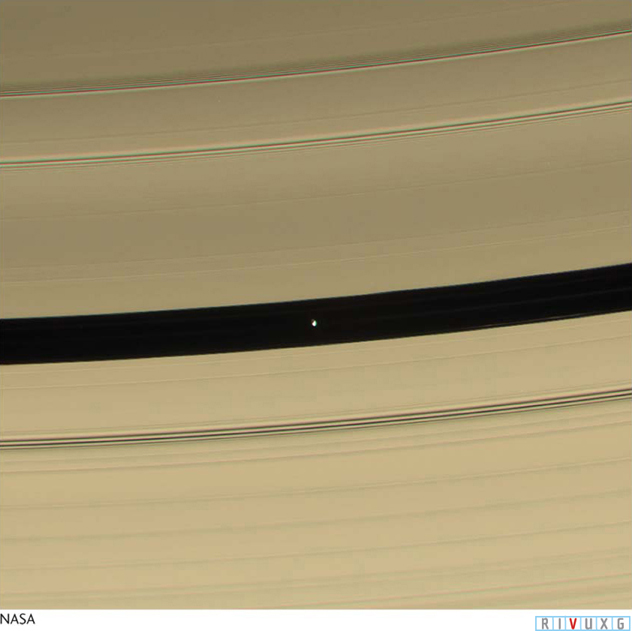
Figure 7-25:  The Moon Pan Orbiting in the Encke division, Pan is the “shepherd” moon that keeps the division clear of small debris. It is the innermost known moon of Saturn.
The Moon Pan Orbiting in the Encke division, Pan is the “shepherd” moon that keeps the division clear of small debris. It is the innermost known moon of Saturn.
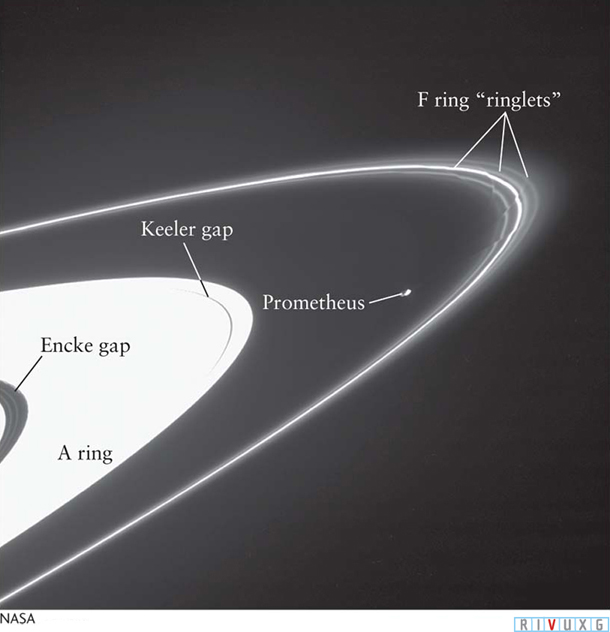
Figure 7-26:  The F Ring and One of Its Shepherds Two tiny satellites, Prometheus and Pandora, each measuring about 50 km (31 mi) across, orbit Saturn on either side of the F ring. Sometimes the ringlets are braided, sometimes parallel to each other. In any case, the passage of the shepherd moons causes ripples in the rings, which lead to the formation of large snowballs in them. The gravitational effects of these two shepherd satellites confine the particles in the F ring to a band about 100 km (62 mi) wide.
The F Ring and One of Its Shepherds Two tiny satellites, Prometheus and Pandora, each measuring about 50 km (31 mi) across, orbit Saturn on either side of the F ring. Sometimes the ringlets are braided, sometimes parallel to each other. In any case, the passage of the shepherd moons causes ripples in the rings, which lead to the formation of large snowballs in them. The gravitational effects of these two shepherd satellites confine the particles in the F ring to a band about 100 km (62 mi) wide.
The Voyager cameras sent back the first high-quality pictures of the F ring, a thin set of ringlets just beyond the outer edge of the A ring (Figure 7-26). Two tiny moons, Prometheus and Pandora, have orbits on either side of the F ring and serve to keep it intact. The outer of the two satellites orbits Saturn at a slower speed than do the ice particles in the ring, as governed by Kepler’s third law. As the ring particles pass near it, they receive a tiny, backward gravitational tug, which slows them down, causing them to fall into orbits a bit closer to Saturn. Meanwhile, the inner satellite orbits the planet faster than the F ring particles. This moon’s gravitational force pulls them forward and nudges the particles back into a higher orbit. The combined effect of these two satellites focuses the icy particles into a well-defined, narrow band about 100 km (62 mi) wide. In 2010, the Cassini spacecraft observed snowballs as large as 20 km (12 mi) in diameter forming in the F ring. These bodies form as small bits of the F ring debris swirl around and collide with each other under the gravitational attractive force of the passing moon Prometheus. At other times, large pieces collide and break into smaller ones.
Because of their confining influence, Prometheus and Pandora are called shepherd satellites or shepherd moons. Among the most curious features of the F ring is that the ringlets are sometimes braided or intertwined and sometimes separate. Although stabilized by the shepherd moons, the F ring does ripple and shows varying brightness. Astronomers theorize that the changes in brightness result from collisions between clumps of matter in the ring.
A promising theory has been put forth to explain the origin of the ice-rich rings of Saturn that we have just been discussing. Just as the planets formed in a disk around the protosun, astronomers believe that Saturn’s largest moons, including Rhea, Titan, and Iapetus, formed in a disk of gas and dust orbiting the young Saturn. (We discuss these moons shortly.) Another moon is posited to have formed at the same time in an orbit closer to Saturn than these moons. Recall from the Nice model (Section 4-3) that Saturn formed during a period in which there were myriad pieces of debris in its orbit and crossing its orbit. That debris took energy away from Saturn, which is why it initially spiraled sunward. The theory proposes that the innermost moon, buffeted by the same debris, lost energy and spiraled inward toward Saturn. Eventually, it crossed the Roche limit, the distance at which a planet creates tides on a moon’s solid surface high enough to pull the moon apart. The tidal force stressed the moon, causing much of the ice-rich surface to be stripped off and inserted into orbit as the denser rocky debris continued spiraling inward until it sank into the planet. The remaining icy debris became the major rings of Saturn. As one would expect from this theory, these rings are all inside Saturn’s Roche limit.
Saturn’s rings are being struck by small pieces of space debris, or meteors, ranging in size from a centimeter to several meters across. These events, which occur several times every day, create temporary streaks or ripples across the rings. It appears that many of these meteors are broken up by impacts with ring debris, after which they become new ring matter.
Beyond the major rings described here and well outside Saturn’s Roche limit lie extensive rings of very fine dust particles, typically smaller than a millionth of a meter (a micron) across. Because such rings are very unstable (that is, the particles are drifting away from each other), there must be small moons that stabilize the rings and replace lost debris. The moons Janus, Epimetheus, and Pallene are associated with these rings. Their gravitational attractions slow the loss of the dust while also providing replacement particles.
Figure 7-27a shows a Cassini image of part of this system, including a ring discovered in the orbit of the moon Pallene. The Cassini image in Figure 7-27b gives us a more comprehensive view of Saturn’s ring system. Nevertheless, the rings go out farther still. The ring system shown in Figure 7-27c actually extends out to Titan, 1.2 million km (750,000 mi) from Saturn. In 2009, astronomers using the Spitzer Space Telescope observed a separate ring in the same orbit as the moon Phoebe (Figure 7-28), 13 million km (8.1 million mi) from Saturn. Called the Phoebe ring, its particles are believed to come from that moon, probably ejected as a result of meteorite impacts. Unlike the main ring system, which orbits over Saturn’s equator, the Phoebe ring is inclined 27° from the equator.

Figure 7-27: 

 Saturn’s Ring System (a) Photographed with the Sun behind Saturn, the inner and intermediate regions of Saturn’s ring system are shown to be very different from each other. Beyond the F ring, the particles are dust and pebble-sized. (b) Another view of the inner and intermediate rings, where subtle color differences are indicated. (c) Superimposed on this Cassini image are labels that indicate how far the rings extend into the moon system of Saturn. Titan (off image on right) is 1.2 million km (750,000 mi) from the center of Saturn.
Saturn’s Ring System (a) Photographed with the Sun behind Saturn, the inner and intermediate regions of Saturn’s ring system are shown to be very different from each other. Beyond the F ring, the particles are dust and pebble-sized. (b) Another view of the inner and intermediate rings, where subtle color differences are indicated. (c) Superimposed on this Cassini image are labels that indicate how far the rings extend into the moon system of Saturn. Titan (off image on right) is 1.2 million km (750,000 mi) from the center of Saturn.

Figure 7-28:  Saturn and Its Outer Giant Ring This artist’s rendition of Saturn’s giant ring is drawn to scale with an infrared image of Saturn and the rings we normally see. The giant ring spans the region from 6 million km (3.7 million mi) to 18 million km (11.1 million mi) beyond Saturn. Put another way, the giant ring is as wide as 30 Saturns placed side by side.
Saturn and Its Outer Giant Ring This artist’s rendition of Saturn’s giant ring is drawn to scale with an infrared image of Saturn and the rings we normally see. The giant ring spans the region from 6 million km (3.7 million mi) to 18 million km (11.1 million mi) beyond Saturn. Put another way, the giant ring is as wide as 30 Saturns placed side by side.
Returning to the inner rings, pictures from the Cassini spacecraft and the Hubble Space Telescope show that the bulk of Saturn’s rings lies in a remarkably thin disk—about 10 m (33 ft) thick according to recent observations! This value is amazing when you consider that the total ring system has a width (from inner edge to outer edge) of over 380,000 km (236,000 mi), more than the distance from Earth to our Moon. In 2009, when the rings were seen edge-on from Earth, astronomers discovered that small amounts of ring material extend up to 18,000 km (11,200 mi) above and below the plane of the rings, probably pulled out by the gravitational attraction of Saturn’s moons and by the planet’s magnetic field. In 2006, Cassini discovered a new class of small moons, called moonlets, orbiting in Saturn’s rings. As many as 10 million of them may exist there. One theory is that they are pieces of a larger body (see Figure 7-24) that broke up to form the rings.
The particles that form Saturn’s rings must be highly reflective because the rings are very bright (their albedo is 0.80). Astronomers had long suspected that the rings consist primarily of water ice, along with ice-coated rocks. Spectra taken by Earth-based observatories and by the spacecraft visiting Saturn have confirmed this suspicion. While the temperature of the rings ranges from 93 K (−90°F) in the sunshine to less than 73 K (−330°F) in Saturn’s shadow, water particles are nevertheless being freed from them, probably by ultraviolet radiation from the Sun. The water particles are guided toward Saturn by the planet’s magnetic fields, where they combine with other particles in Saturn’s upper atmosphere.
Saturn’s rings are slightly salmon-colored. This coloring suggests that they contain traces of organic molecules, which often have such hues. It appears that the rings have gained this material by being bombarded with debris from the outer solar system.
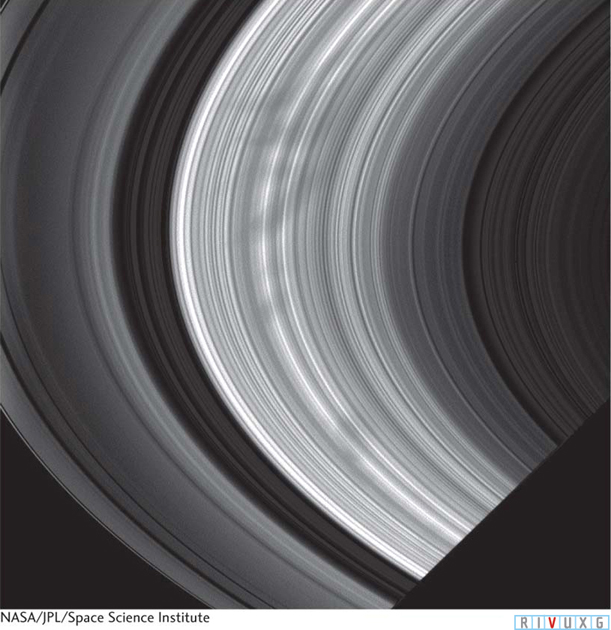
Figure 7-29:  Spokes in Saturn’s Rings Believed to be caused by Saturn’s magnetic field moving electrically charged particles that are lifted out of the ring plane, these dark regions move around the rings like the spokes on a rotating wheel.
Spokes in Saturn’s Rings Believed to be caused by Saturn’s magnetic field moving electrically charged particles that are lifted out of the ring plane, these dark regions move around the rings like the spokes on a rotating wheel.
To determine the size of the particles in Saturn’s rings, scientists measured the brightness of different rings from many angles as the Voyager and Cassini spacecraft flew past the planet. Astronomers also measured changes in radio signals received from these spacecraft as they passed behind the rings. Different rings are composed of debris with different sizes, ranging from particles of the sizes found in wood smoke, through those a few centimeters across, to particles roughly 10 m (11 yd) in diameter. The outermost main ring, the A ring (see Figure 7-24), is composed of these larger clumps of rubble, which frequently collide with one another and thereby change sizes. This ongoing process is analogous to the planet-formation activity described in Chapter 4. Of the particles that would be visible to the naked eye (that is, excluding dust particles), the centimeter-sized particles are most common.
 High-resolution images reveal that the ring structure as seen from Earth actually consists of thousands of closely spaced ringlets (Figure 7-29).
High-resolution images reveal that the ring structure as seen from Earth actually consists of thousands of closely spaced ringlets (Figure 7-29).
Saturn’s layer of liquid metallic hydrogen produces a planetwide magnetic field that affects its rings. Due to Saturn’s much smaller volume of liquid metallic hydrogen, the magnetic field at Saturn’s surface is only about two-thirds as strong as the magnetic field here on Earth. Data from spacecraft show that Saturn’s magnetosphere contains radiation belts similar to Earth’s Van Allen belts. Furthermore, dark spokes move around Saturn’s rings (see Figure 7-29); these are believed to be created by electric charges on the ring material interacting with the planet’s magnetic field. The magnetic field lifts charged particles out of the plane in which the rings orbit. Spreading the particles out decreases the light scattered from them and therefore makes the rings appear darker. The magnetic field, moving with the planet as it rotates, causes the regions of spread particles to change, making the spokes appear to revolve around the planet.
7-11 Titan has a thick atmosphere, clouds, and lakes filled with liquids
Only seven of Saturn’s 62 known moons are spherical. Four of them are shown in Figure 7-30a–c, e. The other 55 moons are oblong, suggesting that they are captured asteroids. These oblong satellites include Phoebe (Figure 7-30d) and Hyperion (Figure 7-30f). Twelve oblong moons discovered in 2001 move in clumps, suggesting that they are pieces of a larger body that was broken up by impacts.

Figure 7-30:  Saturn’s Diverse Moons (a–c) These Voyager 1, Voyager 2, and Cassini images show the variety of surface features seen on three of Saturn’s seven spherical moons. They are not shown to scale (refer to the diameters given below each image). (d) In comparison, this Cassini image shows the nonspherical moon Phoebe, almost as dark as coal, carrying many craters, landslides, grooves, and ridges. Phoebe is barely held in orbit by Saturn. Astronomers believe that it was captured after wandering in from beyond the orbit of Neptune. Two particularly intriguing moons are (e) Iapetus and (f) Hyperion. The ridge running along the equator of Iapetus is believed to have developed as the moon formed. Apparently Iapetus cooled so rapidly that the ridge did not have time to settle away. Perhaps the most bizarre object photographed in the solar system, ice-covered Hyperion, shows innumerable impact craters. These features are different from craters seen in other objects in that the crater walls here have not filled in the bottom of the craters. This moon’s low gravity and the pull of nearby Titan may explain this unusual phenomenon.
Saturn’s Diverse Moons (a–c) These Voyager 1, Voyager 2, and Cassini images show the variety of surface features seen on three of Saturn’s seven spherical moons. They are not shown to scale (refer to the diameters given below each image). (d) In comparison, this Cassini image shows the nonspherical moon Phoebe, almost as dark as coal, carrying many craters, landslides, grooves, and ridges. Phoebe is barely held in orbit by Saturn. Astronomers believe that it was captured after wandering in from beyond the orbit of Neptune. Two particularly intriguing moons are (e) Iapetus and (f) Hyperion. The ridge running along the equator of Iapetus is believed to have developed as the moon formed. Apparently Iapetus cooled so rapidly that the ridge did not have time to settle away. Perhaps the most bizarre object photographed in the solar system, ice-covered Hyperion, shows innumerable impact craters. These features are different from craters seen in other objects in that the crater walls here have not filled in the bottom of the craters. This moon’s low gravity and the pull of nearby Titan may explain this unusual phenomenon.
Saturn’s largest moon, Titan, is second in size to Ganymede among the moons of the solar system and is the only moon in the solar system found to have a dense atmosphere. Like many of the other moons of Saturn, Titan is in synchronous rotation around the planet. About 10 times more gas lies above each square meter of Titan’s surface than lies above each square meter of Earth. As a result, the air pressure on the surface of Titan is about 1.5 times the air pressure we feel on Earth.
Christiaan Huygens discovered Titan in 1655, the same year he proposed that Saturn has rings. By the early 1900s, several scientists had begun to suspect that Titan might have an atmosphere. This moon is larger (although less massive) than Mercury and far colder than that planet. Calculations reveal that Titan is cool enough and massive enough to retain heavy gases in its atmosphere. Because of this, Titan was a primary target for the Voyager missions (Figure 7-31a). Unexpectedly, its thick haze completely blocked any view of its surface by Voyager’s relatively primitive cameras. Observations also reveal that clouds of methane form and dissipate seasonally near both of Titan’s poles and in the mid-southern latitudes. Although the causes for the appearance and disappearance of these clouds are not all known, geysers and evaporation from Titan’s lakes are considered as possible factors.
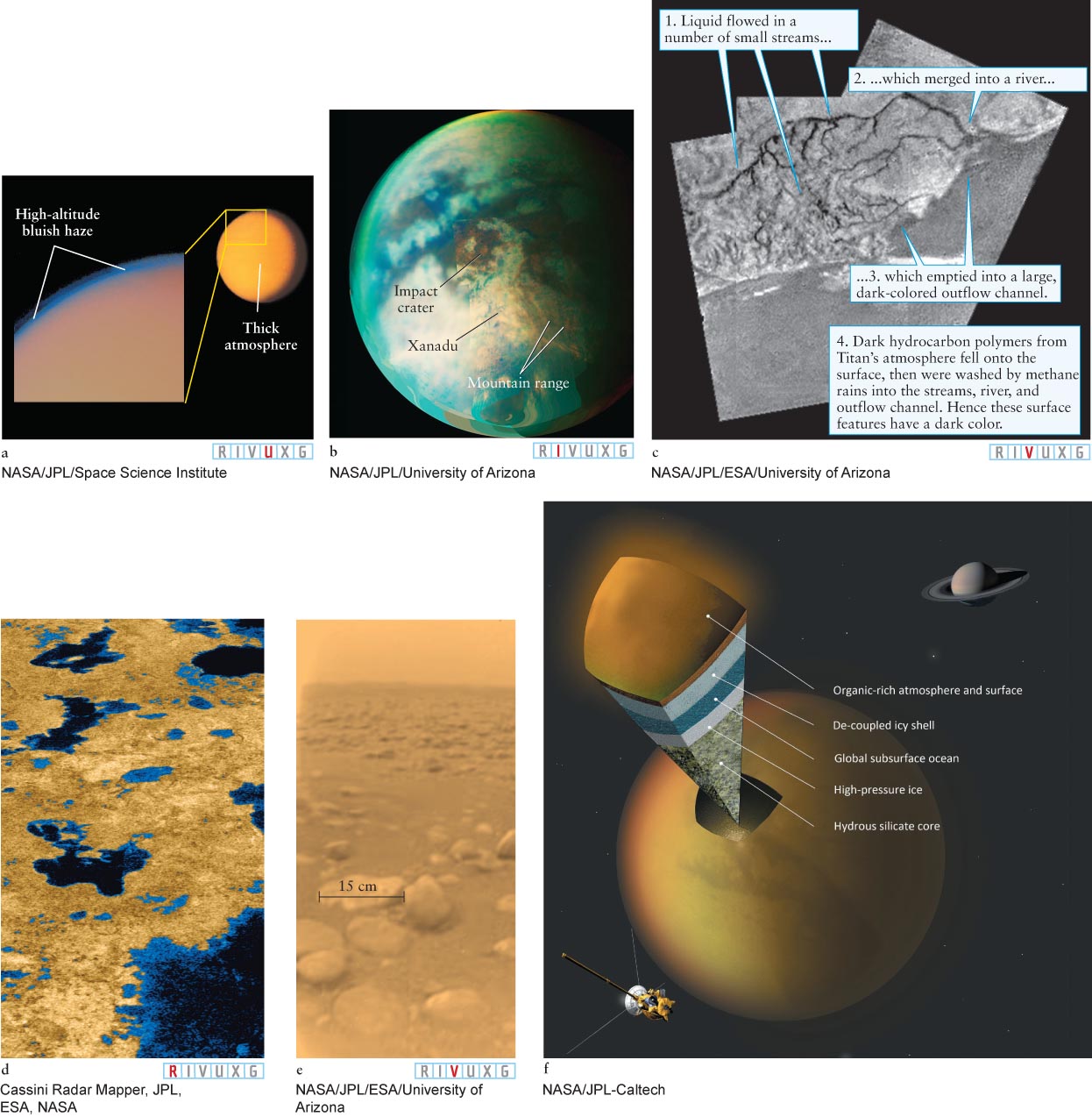
Figure 7-31: 



 Surface Features on Titan (a) Voyager images of Titan’s smoggy atmosphere. (b) Cassini image of Titan (diameter 5150 km or 3200 mi) showing lighter highlands, called Xanadu, and dark, flat, lowlands that may be hydrocarbon seas. Resolution is 4.2 km (2.6 mi). (c) Riverbeds meandering across the Xanadu highlands of Titan. These are believed to have been formed by the flow of liquid methane and ethane. (d) Lakes filled with liquid methane and ethane. (e) The Huygens probe took this image at Titan’s surface on January 14, 2005. What appear like boulders here are actually pebbles strewn around the landscape. The biggest ones are about 15 cm (6 in.) across. (f) Our present understanding of Titan’s structure.
Surface Features on Titan (a) Voyager images of Titan’s smoggy atmosphere. (b) Cassini image of Titan (diameter 5150 km or 3200 mi) showing lighter highlands, called Xanadu, and dark, flat, lowlands that may be hydrocarbon seas. Resolution is 4.2 km (2.6 mi). (c) Riverbeds meandering across the Xanadu highlands of Titan. These are believed to have been formed by the flow of liquid methane and ethane. (d) Lakes filled with liquid methane and ethane. (e) The Huygens probe took this image at Titan’s surface on January 14, 2005. What appear like boulders here are actually pebbles strewn around the landscape. The biggest ones are about 15 cm (6 in.) across. (f) Our present understanding of Titan’s structure.
Voyager data indicated that roughly 90% of Titan’s atmosphere is nitrogen. Most of this gas probably formed from the breakdown of ammonia (NH3) into hydrogen and nitrogen atoms under the influence of the Sun’s ultraviolet radiation. Because Titan’s gravity is too weak to retain hydrogen, this gas has escaped into space, leaving behind ample nitrogen. The unbreathable atmosphere is about 4 times as dense as that of Earth.
The second most abundant gas on Titan is methane, a major component of natural gas. Sunlight interacting with methane induces chemical reactions that produce a variety of other carbon-hydrogen compounds, or hydrocarbons. Spacecraft have detected small amounts of nearly 20 hydrocarbons in Titan’s atmosphere, including ethane (C2H6), acetylene (C2H2), ethylene (C2H4), and propane (C3H8).
Methane and ethane condense into droplets in the cold air, making Titan the only other world in the solar system besides Earth where rain reaches the surface. The rain, however, is very different on the two worlds. Titan’s raindrops are calculated to be 1 cm (0.4 in) in diameter (roughly twice the size of large raindrops on Earth) and, because of Titan’s low surface gravity, they fall 6 times more slowly than raindrops do here—rain on Titan falls at the speed of slowly falling snowflakes on Earth. Nitrogen combines with various hydrocarbons to produce other compounds that can exist as liquids on Titan. Although one of these compounds, hydrogen cyanide (HCN), is a poison, some of the others are the building blocks of life’s organic molecules. Indeed, biologists who study Titan’s atmosphere now think that its chemistry is very similar to that of the young Earth.
Focus Question 7-10
What liquids appear to exist on Titan?
Many of the hydrocarbons and carbon-nitrogen can form complex compounds called polymers. These molecules are long repeating chains of atoms; rubber, cellulose, and plastics are the best-known examples on Earth. Scientists hypothesize that droplets of lighter polymers remain suspended in Titan’s atmosphere and form a mist, while heavier polymer particles settle down onto Titan’s surface.
Images of the surface taken by the Cassini spacecraft (Figure 7-31b), which arrived in the Saturn system in 2004, show few craters, indicating that Titan’s surface undergoes dynamic change. Despite the fact that activity in its atmosphere and surface continually covers craters and other surface features, Titan does have a (presumably long-lived) mountain range with peaks as high as 1.5 km (1 mi). These peaks are covered with organic matter and possible methane snow.
About 20% of Titan’s surface has sand dunes 100 m (109 yd) high. The composition of the sand is not yet clear, although it may be made of frozen organic molecules. Using the Keck I telescope in 1999, astronomers observed infrared emissions from Titan’s surface consistent with a partially liquid surface. Rain and rivers of methane have been observed (Figure 7-31c). In 2007, radar images from Cassini revealed a smooth dark surface of over 105 km2 (39,000 mi2), the largest lake of liquid methane and ethane seen on Titan. Other images, such as Figure 7-31d, reveal similar features elsewhere on that world, including islands in some lakes. Titan’s lakes are all located near its poles.
Cassini launched a probe named Huygens that successfully parachuted onto Titan and photographed rocks (Figure 7-31e), highlands, and channels. Upon impact, Huygens vaporized methane that had been just centimeters below the surface. The quantity of methane and ethane detected there implies that Titan has reservoirs of these and other hydrocarbons, which are continually being broken down in its atmosphere by the Sun’s ultraviolet radiation.
We have little reason to suspect that life exists on Titan’s surface because the temperature there, 95 K (−288°F), is prohibitively cold. However, in 2008 astronomers using data from Cassini discovered that surface features, including lakes, canyons, even mountains, drift some 15 km (9.3 mi) per year. They concluded that this drift is possible because a layer of liquid water and ammonia exists 100 km (62 mi) under Titan’s surface. That layer acts as a lubricant that allows the surface to move relative to the deep interior, which has been determined to be a mix of rock and ice. The combination of liquid water and organic compounds, such as methane, may enable life to have evolved inside Titan. Our present understanding of Titan’s interior structure is summarized in Figure 7-31f.
7-13 Enceladus has water jets, an atmosphere, and a magnetic field
Focus Question 7-11
Besides Mercury, what other world that we have studied has scarps?
Saturn’s sixth-largest moon, Enceladus (500 km [310 mi] in diameter, Figure 7-33a), moved from the sidelines toward center stage in 2005 as Cassini began studying it. This bright world has an icy, wrinkled surface similar in appearance to Jupiter’s Europa and Ganymede. The fact that these latter two bodies contain liquid water was the first clue that Enceladus does, too. This conclusion is supported by observations that entire regions of Enceladus’s southern hemisphere are free of craters. Instead, there are ice blocks the size of large houses, which have apparently erased many craters due to tectonic plate motion (Figure 7-33b). In addition, the spacecraft revealed that dark lines on Enceladus, dubbed tiger stripes (Figure 7-33a), are less than 1000 years old. These features, much warmer than the surrounding surface and heated from below, are cracks through which water wells up from inside, freezing into a smooth, dark surface. The tiger stripes are typically 100 km (62 mi) long and 35 km (22 mi) apart.

Figure 7-33: 

 Enceladus (a) Cassini view of the two distinct landscapes on Enceladus, one heavily cratered, the other nearly crater-free. The blue “tiger stripes” are believed to be due to upwelling of liquid that froze at the surface. (b) The crater-free region near the south pole. The ridges are thought to be created by tectonic flows. Inset shows ice boulders. (c) Icy particles ejected from Enceladus may be continually coming out of the moon.
Enceladus (a) Cassini view of the two distinct landscapes on Enceladus, one heavily cratered, the other nearly crater-free. The blue “tiger stripes” are believed to be due to upwelling of liquid that froze at the surface. (b) The crater-free region near the south pole. The ridges are thought to be created by tectonic flows. Inset shows ice boulders. (c) Icy particles ejected from Enceladus may be continually coming out of the moon.
Proof positive that Enceladus has liquid water inside it came in 2007 when jets of water were first seen shooting out of it at speeds up to 2200 km/h (1400 mi/h) from the regions of the tiger stripes (Figure 7-33c). The most promising explanation for the origin of the liquid water and the cause of the recent formation of the tiger stripes is the heating of Enceladus by the tidal force from Saturn. Similar to how Jupiter’s and Europa’s gravitational forces cause Io to change shape and thereby heat as it orbits, the gravitational forces from Saturn and its host of other moons cause Enceladus to change shape. This motion creates internal friction and heat that keep a large volume of water inside Enceladus liquid, while also stressing the surface, allowing the tiger stripes to form.
Observations indicate that this water leaves Enceladus cyclically; when the moon is farthest from the planet, water emerges in relatively steady jets (unlike geysers on Earth, which send up water in spurts). When Enceladus is close to Saturn, the jets are turned off. Tides on the moon explain this behavior. When Enceladus is close to Saturn, the tidal force from the planet adjusts the moon’s surface shape to stop the jets of water, whereas when Enceladus is farther from the planet, the moon’s shape is altered, opening gaps through which the water is ejected. Because Enceladus lacks sufficient gravitational attraction to pull all the water it ejects down onto its icy surface, this moon is continually losing mass.
Cassini’s detectors also discovered that Enceladus has a thin atmosphere and a magnetic field (consistent with salty liquid water in its interior). Besides water vapor, the atmosphere of Enceladus is composed of hydrogen, carbon dioxide, nitrogen, carbon monoxide, and organic compounds. Cassini also detected dust and salt-rich ice grains surrounding Enceladus. This material is the source of Saturn’s E ring.
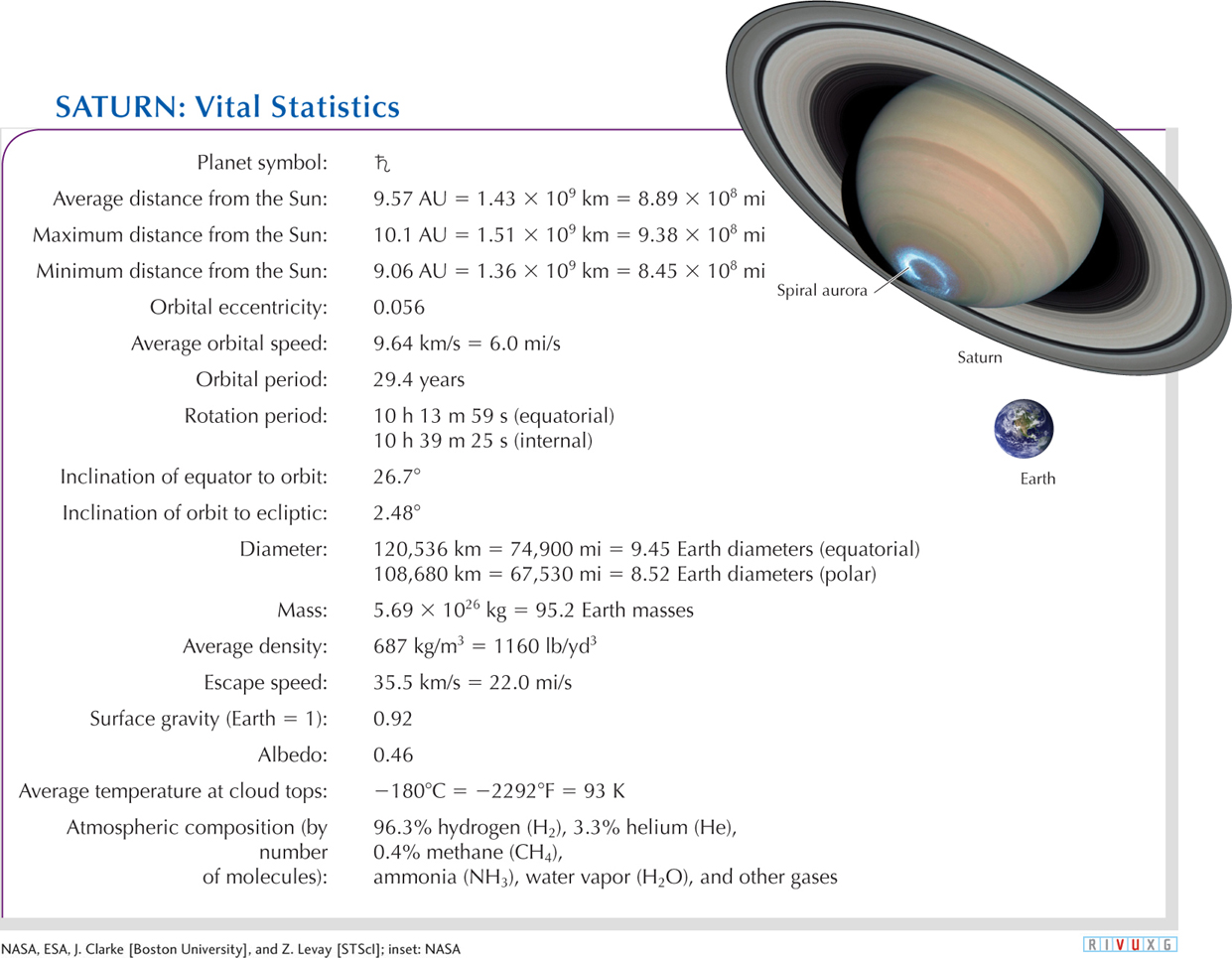
 Saturn and Its Vital Statistics Combined visible and ultraviolet images from the Hubble Space Telescope reveal spiral arcs of auroras near Saturn’s south pole. The inset image of Earth shows its size relative to Saturn. Note that there is much less contrast between Saturn’s clouds than those of Jupiter.
Saturn and Its Vital Statistics Combined visible and ultraviolet images from the Hubble Space Telescope reveal spiral arcs of auroras near Saturn’s south pole. The inset image of Earth shows its size relative to Saturn. Note that there is much less contrast between Saturn’s clouds than those of Jupiter.


 Belts and Zones on Saturn (a) Observing in the infrared, Cassini took this view of a hexagonal pattern of clouds that rotates much more slowly than the surrounding belts and zones. The pattern’s origin is still under investigation. (b) Observed in visible light, the north pole is covered by and encircled by huge storms, imaged by Cassini in 2012.
Belts and Zones on Saturn (a) Observing in the infrared, Cassini took this view of a hexagonal pattern of clouds that rotates much more slowly than the surrounding belts and zones. The pattern’s origin is still under investigation. (b) Observed in visible light, the north pole is covered by and encircled by huge storms, imaged by Cassini in 2012.

 Merging Storms on Saturn (a–
Merging Storms on Saturn (a–
 Saturn as Seen from Earth Saturn’s rings are aligned with its equator, which is tilted 27° from the plane of Saturn’s orbit around the Sun. Therefore, Earth-
Saturn as Seen from Earth Saturn’s rings are aligned with its equator, which is tilted 27° from the plane of Saturn’s orbit around the Sun. Therefore, Earth-
 Numerous Thin Ringlets Constitute Saturn’s Inner Rings (a) This Cassini image shows some of the structure of Saturn’s rings, including some of the moonlets orbiting in them. Lower inset: As moons orbit near or between rings, they often cause the ring ices to develop ripples, like the grooves in a phonograph record. Three insets on right: Circles indicate four moonlets in the A ring. (b) Debris piles up along the outer edge of Saturn’s B ring just inside the Cassini division. Note the shadows of this material, indicating how irregular this edge is compared to the body of the ring. (c) Viewing Saturn’s night side, the smaller pieces of debris scatter light from the Sun forward toward the Cassini spacecraft, including dust-
Numerous Thin Ringlets Constitute Saturn’s Inner Rings (a) This Cassini image shows some of the structure of Saturn’s rings, including some of the moonlets orbiting in them. Lower inset: As moons orbit near or between rings, they often cause the ring ices to develop ripples, like the grooves in a phonograph record. Three insets on right: Circles indicate four moonlets in the A ring. (b) Debris piles up along the outer edge of Saturn’s B ring just inside the Cassini division. Note the shadows of this material, indicating how irregular this edge is compared to the body of the ring. (c) Viewing Saturn’s night side, the smaller pieces of debris scatter light from the Sun forward toward the Cassini spacecraft, including dust-
 The Moon Pan Orbiting in the Encke division, Pan is the “shepherd” moon that keeps the division clear of small debris. It is the innermost known moon of Saturn.
The Moon Pan Orbiting in the Encke division, Pan is the “shepherd” moon that keeps the division clear of small debris. It is the innermost known moon of Saturn.

 The F Ring and One of Its Shepherds Two tiny satellites, Prometheus and Pandora, each measuring about 50 km (31 mi) across, orbit Saturn on either side of the F ring. Sometimes the ringlets are braided, sometimes parallel to each other. In any case, the passage of the shepherd moons causes ripples in the rings, which lead to the formation of large snowballs in them. The gravitational effects of these two shepherd satellites confine the particles in the F ring to a band about 100 km (62 mi) wide.
The F Ring and One of Its Shepherds Two tiny satellites, Prometheus and Pandora, each measuring about 50 km (31 mi) across, orbit Saturn on either side of the F ring. Sometimes the ringlets are braided, sometimes parallel to each other. In any case, the passage of the shepherd moons causes ripples in the rings, which lead to the formation of large snowballs in them. The gravitational effects of these two shepherd satellites confine the particles in the F ring to a band about 100 km (62 mi) wide.



 Saturn’s Ring System (a) Photographed with the Sun behind Saturn, the inner and intermediate regions of Saturn’s ring system are shown to be very different from each other. Beyond the F ring, the particles are dust and pebble-
Saturn’s Ring System (a) Photographed with the Sun behind Saturn, the inner and intermediate regions of Saturn’s ring system are shown to be very different from each other. Beyond the F ring, the particles are dust and pebble-
 Saturn and Its Outer Giant Ring This artist’s rendition of Saturn’s giant ring is drawn to scale with an infrared image of Saturn and the rings we normally see. The giant ring spans the region from 6 million km (3.7 million mi) to 18 million km (11.1 million mi) beyond Saturn. Put another way, the giant ring is as wide as 30 Saturns placed side by side.
Saturn and Its Outer Giant Ring This artist’s rendition of Saturn’s giant ring is drawn to scale with an infrared image of Saturn and the rings we normally see. The giant ring spans the region from 6 million km (3.7 million mi) to 18 million km (11.1 million mi) beyond Saturn. Put another way, the giant ring is as wide as 30 Saturns placed side by side.

 Spokes in Saturn’s Rings Believed to be caused by Saturn’s magnetic field moving electrically charged particles that are lifted out of the ring plane, these dark regions move around the rings like the spokes on a rotating wheel.
Spokes in Saturn’s Rings Believed to be caused by Saturn’s magnetic field moving electrically charged particles that are lifted out of the ring plane, these dark regions move around the rings like the spokes on a rotating wheel.
 High-
High-
 Saturn’s Diverse Moons (a–
Saturn’s Diverse Moons (a–




 Surface Features on Titan (a) Voyager images of Titan’s smoggy atmosphere. (b) Cassini image of Titan (diameter 5150 km or 3200 mi) showing lighter highlands, called Xanadu, and dark, flat, lowlands that may be hydrocarbon seas. Resolution is 4.2 km (2.6 mi). (c) Riverbeds meandering across the Xanadu highlands of Titan. These are believed to have been formed by the flow of liquid methane and ethane. (d) Lakes filled with liquid methane and ethane. (e) The Huygens probe took this image at Titan’s surface on January 14, 2005. What appear like boulders here are actually pebbles strewn around the landscape. The biggest ones are about 15 cm (6 in.) across. (f) Our present understanding of Titan’s structure.
Surface Features on Titan (a) Voyager images of Titan’s smoggy atmosphere. (b) Cassini image of Titan (diameter 5150 km or 3200 mi) showing lighter highlands, called Xanadu, and dark, flat, lowlands that may be hydrocarbon seas. Resolution is 4.2 km (2.6 mi). (c) Riverbeds meandering across the Xanadu highlands of Titan. These are believed to have been formed by the flow of liquid methane and ethane. (d) Lakes filled with liquid methane and ethane. (e) The Huygens probe took this image at Titan’s surface on January 14, 2005. What appear like boulders here are actually pebbles strewn around the landscape. The biggest ones are about 15 cm (6 in.) across. (f) Our present understanding of Titan’s structure.
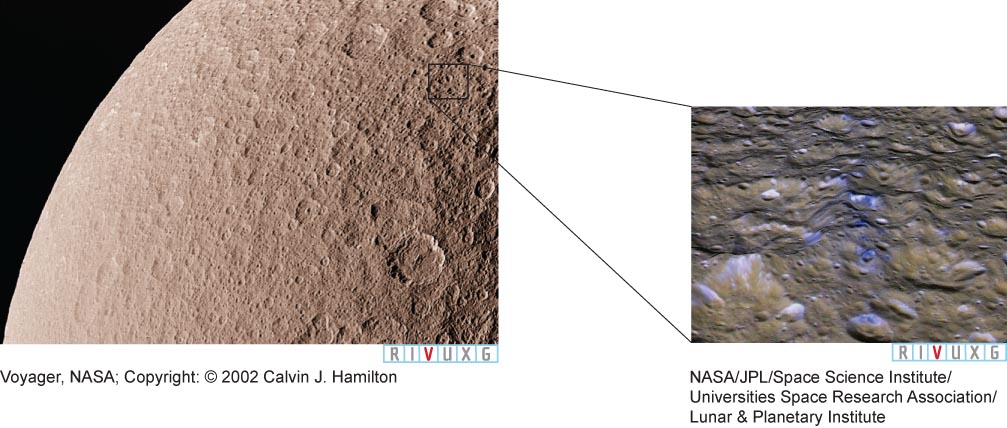

 Rhea Rhea (diameter 1530 km or 950 mi) is heavily cratered. The bluish regions on the inset are believed to be ices uncovered as a result of impacts.
Rhea Rhea (diameter 1530 km or 950 mi) is heavily cratered. The bluish regions on the inset are believed to be ices uncovered as a result of impacts.



 Enceladus (a) Cassini view of the two distinct landscapes on Enceladus, one heavily cratered, the other nearly crater-
Enceladus (a) Cassini view of the two distinct landscapes on Enceladus, one heavily cratered, the other nearly crater-